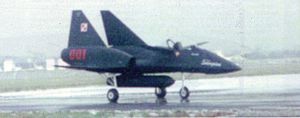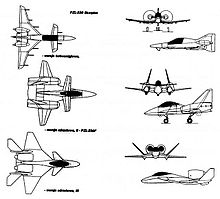- PZL-230 Skorpion
-
Skorpion PZL-230F Skorpion mockup Role Ground attack aircraft Manufacturer PZL Designer Andrzej Frydrychewicz Status Cancelled Primary user Polish Air Force Number built 0 The PZL-230 Skorpion was a design for a Polish Air Force attack aircraft. The project was started in the late 1980s by the PZL (Polish State Aviation Works) and cancelled in 1994 due to a lack of funds. Skorpion would have had twin jet engines, a fuselage afterbody blending into the wing and small canards behind the cockpit.[1]
Contents
History
The project was developed by a team under Andrzej Frydrychewicz at PZL Okęcie, analyzing the experiences of modern wars, such as that in Vietnam and the Soviet war in Afghanistan and capitalizing on their experience with other recent Polish designs like the Orlik. Among the desired capabilities were Short Take-Off and Landing (STOL) and maneuverability but with armored protection. It had to be cheap, easy to build and modify (due to its modular design). The early variant incorporated a single pilot, twin jet engines mounted on the upper fuselage like the A-10 Thunderbolt II and canard-type construction. It also required an ability to take-off and land on a runway of about 250 m in length, travel at speeds of up to 640 km/h, be armed with a 25 mm cannon and be able to carry up to 2,000 kg of both Warsaw Pact and NATO munitions. Composites, fly-by-wire and other advanced avionics were also to be used in its construction.
In 1990 the design was changed, the Polish Ministry of Defense demanded a top speed of 1,000 km/h and an ability to carry 4,000 kg of equipment. The redesigned Skorpion became a heavier aircraft, the engines were moved into the central body. The changes required that the required runway length be extended to 400 m. The new design was also flatter, thus acquiring some stealth capabilities. This version was known as the 230F. A model of the 'F' version was constructed in 1992.
Later versions were named 'D', and included a 'DT' training aircraft and a 'DB' combat variant. In 1993 the project was accepted by the airforce, but due to budget cuts it was cancelled in 1994.
Feasibility
The PZL-230 was an ambitious undertaking for Poland, critics argued from the beginning that it was too ambitious. In the early days of the project, Polish aeorospace manufacturing in the People's Republic of Poland was subservient to that of the Soviet Union and limited to their innovations. After the events of 1989, Poland could import more Western technology, but she was also affected by the economic transformation from a communist to a capitalist economic system. The post-1989 government had other priorities than military. Although some reviews and evaluations indicated that — according to the specifications — the PZL-230 could have become one of the most efficient of the contemporary attack planes,[citation needed] and many argued that the PZL-230 could become an export hit,[citation needed] it was eventually cancelled. Today, the PZL-230 project is remembered as one of the most ingenious post-Second World War Polish airplane programs.[citation needed].
Specifications (PZL-230D)
General characteristics
- Crew: 1 (pilot)
- Length: 10 m (32 ft 10 in)
- Wingspan: 12.1 m (39 ft 8 in)
- Height: 4.2 m (13 ft 9 in)
- Wing area: 25.4 m2 (273 sq ft)
- Gross weight: 11,000 kg (24,251 lb)
Performance
- Maximum speed: 1,000 km/h (620 mph; 540 kn)
- Maximum speed: Mach 0.85
- Combat range: 300 km (186 mi; 162 nmi)
- Service ceiling: 12,000 m (39,370 ft)
- Rate of climb: 90 m/s (18,000 ft/min)
- Takeoff distance: 300 metres (980 ft)
Armament
- Internal gun; up to 4,000 kilograms (8,800 lb) ordnance
See also
References
- ^ Digital copy of an entry from the Encyclopedia of World Aircraft: The PZL-230F Skorpion. Fighters, Bombers and Recon Discussion Board, at 2011 StrategyWorld.com. Retrieved November 9, 2011.
- This article incorporates information from the revision as of 5 April 2006 of the equivalent article on the Polish Wikipedia.
- (Polish) PZL-230 SKORPION SAMOLOT POLA WALKI
- (Polish) PZL 230 Skorpion
- (Polish) PZL-230 "Skorpion"
Categories:- Cancelled aircraft projects
- Polish military aircraft 1990–1999
- Polish attack aircraft
- PZL aircraft
Wikimedia Foundation. 2010.


